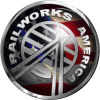First the terminology, consulting various sources it seems that:
Cant = the rotation of the rail tipping it inwards to better meet the coning of railroad wheels and/or to counter the tendency of the outside rail on a curve to roll outwards under the lateral force of a moving train. (IE rail heads are at the same height, but NOT sitting perfectly vertical)
Superelevation = the raising of the outside rail on a curve so that trains are tipped slightly inward toward the center of a curve to counter the lateral forces of a moving train. (IE rail heads are NOT at the same height, and not sitting perfectly vertical)
Some texts seem to use the term Cant for Superelevation: However I accept that there maybe an elevation difference *implied* that I'm overlooking.
So my question is this: When and where did US railroads start using either of these practices? I notice Horseshoe Curve has it in game, and seems to have it in films of back when. Would local or regionals bothered? Would a small 15-20 mile line with 15-20 mph curves have this?
What I've found on the subject seems to show that "All modern highspeed rail use it" (duh...) and an old railway gazette from the 1920's treated it like it was under debate as to if it should or should not be common practice.
Route Building Question: Track Laying Practices circa 1900?
First unread post • 4 posts
• Page 1 of 1
Route Building Question: Track Laying Practices circa 1900?
MSI Gaming 970 (MS-7693), AMD FX-6350/6 Core/3.9Ghz, 16GB Memory, NVIDIA GeForce GTX 1050, Windows 10 Home 64bit
Precision, the quality of being precise...Oh Rly?
-

tg626 - Posts: 124
- Joined: Fri Oct 02, 2015 11:51 am
- Location: Burbank - formerly Balitimore
Re: Route Building Question: Track Laying Practices circa 1900?
Here are some pics from very early 1900s, track just layed in Cimarron Canyon, NM. Show superelevation. I don't think it's merely an artifact of camera tilt.
You do not have the required permissions to view the files attached to this post.
- gwgardner
- Posts: 701
- Joined: Tue Jan 25, 2011 2:34 pm
Re: Route Building Question: Track Laying Practices circa 1900?
Seems like they're banking the whole track from the earthen grade up. Good to know, and more like what the game does as opposed to shimming the rails up which is what was discussed the the Railway Age Gazette article I read (circa 1920). They may have been advocating for it in places where grading the whole bed on a banked angle can't be done, like turnouts etc.
Anyway! Thanks for the reference - is the the Denver & Rio Grande? Post conversion to standard gauge I'm guessing.
Anyway! Thanks for the reference - is the the Denver & Rio Grande? Post conversion to standard gauge I'm guessing.
MSI Gaming 970 (MS-7693), AMD FX-6350/6 Core/3.9Ghz, 16GB Memory, NVIDIA GeForce GTX 1050, Windows 10 Home 64bit
Precision, the quality of being precise...Oh Rly?
-

tg626 - Posts: 124
- Joined: Fri Oct 02, 2015 11:51 am
- Location: Burbank - formerly Balitimore
Re: Route Building Question: Track Laying Practices circa 1900?
It's the St.Louis, Rocky Mountain & Pacific. I modeled it in my Cimarron & Pacific route. Check it out in the library.
- gwgardner
- Posts: 701
- Joined: Tue Jan 25, 2011 2:34 pm
4 posts
• Page 1 of 1
Who is online
Users browsing this forum: No registered users and 2 guests
